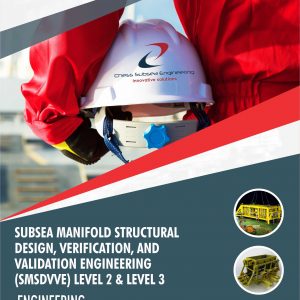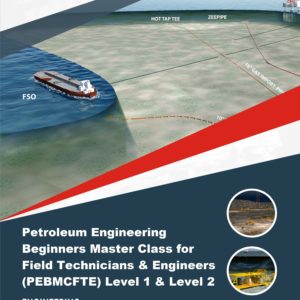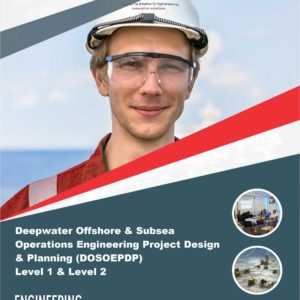Description
The Engineering of Subsea Umbilicals, Risers & Flowlines is an advanced course designed to provide participants with an in-depth understanding of the engineering and design principles involved in subsea systems. The course covers the fundamental aspects of subsea systems, including umbilicals, risers, and flowlines, as well as the associated engineering challenges and solutions.
The course begins with an introduction to the principles and terminology of subsea engineering, including the key components of subsea systems and the main design considerations. It then moves on to cover the engineering and design of subsea umbilicals, including their components, installation, and maintenance. Participants will learn about the different types of umbilical systems, their applications, and the materials used in their construction.
The course also covers the engineering and design of subsea risers, including the different types of risers, their installation, and the factors that impact their performance. Participants will learn about the various riser systems and the materials used in their construction, as well as the design considerations for different types of installations.
Finally, the course addresses the engineering and design of subsea flowlines, including their design, installation, and maintenance. Participants will learn about the different types of flowlines, the materials used in their construction, and the factors that impact their performance.
ESURF Level 1 & Level 2 covers Overview of SURF systems, Functions and applications of SURF, SURF systems environmental considerations, Components of subsea umbilical systems, Types of subsea umbilical system, System requirements of subsea umbilical systems, Depth and pressure considerations of subsea umbilical systems, Material selection and corrosion protection of subsea umbilical systems, FEA and CFD in umbilical system design, FEA and CFD steps in umbilical system design, Fabrication techniques of subsea umbilical systems, Quality control and inspection of subsea umbilical systems, Terminations and end fittings of subsea umbilical systems, Installation techniques of subsea umbilical systems, Testing and commissioning of subsea umbilical systems, Failure Modes and Effects Analysis (FMEA) of subsea umbilical systems, Corrosion management of subsea umbilical systems, Non-destructive testing (NDT) of subsea umbilical systems, Inspection and maintenance of subsea umbilical systems, Repair and replacement of subsea umbilical systems, Components of subsea riser systems, Types of subsea riser systems, System requirements of subsea riser systems, Material selection and corrosion protection of subsea riser systems, Fabrication techniques of subsea riser systems, Quality control and inspection of subsea riser systems, Installation techniques of subsea riser systems, Testing and commissioning of subsea riser systems, Failure Modes and Effects Analysis (FMEA) of subsea riser systems, Corrosion management of subsea riser systems, Non-destructive testing (NDT) of subsea riser systems, Inspection and maintenance of subsea riser systems, Repair and replacement of subsea riser systems, Components of subsea flowline systems, Types of subsea flowline systems, System requirements of subsea flowline systems, Material selection and corrosion protection of subsea flowline systems, Fabrication techniques of subsea flowline systems, Quality control and inspection of subsea flowline systems, Installation techniques of subsea flowline systems, Testing and commissioning of subsea flowline systems, Failure Modes and Effects Analysis (FMEA) of subsea flowline systems, Corrosion management of subsea flowline systems, Non-destructive testing (NDT) of subsea flowline systems, Inspection and maintenance of subsea flowline systems, Repair and replacement of subsea flowline systems, Emerging Technologies and Future Developments in SURF Engineering, Real-world examples of SURF in operation, Lessons learned from past SURF projects, Emerging trends in SURF engineering, Future outlook for the industry and more.
Outlines
What is Flexible Pipe
Types of Flexible Pipe
Comparison of Flexible Pipe Types
Flexible Pipe Application
Advantages of Flexible Pipe
Flexible Pipe Limits
Flexible Pipe Configurations
Flexible Pipe Material Selection
Flexible Pipe Layer Function
Ending Fitting Design critical Issues
Flexible Pipe Design Process
Flexible Pipe Functional Requirements
Flexible Pipe Design Codes & Criteria
Flexible Pipe Structural Design
Flexible Pipe Local Structural Cross-Section Design & Analysis
Flexible Pipe Local Structural Cross-Section Design Models
Flexible Pipe Local Structural Cross-Section Design Models Advantages & Disadvantage
Flexible Pipe Layer Mass Determination using Axi-Symmetric Model
Flexible Pipe Layer Fraction Filled (Ff) Determination using Axi-Symmetric Model
Flexible Pipe Layer Axial Stress Determination using Axi-Symmetric Model
Flexible Pipe Layer Internal Pressure Determination using Axi-Symmetric Model
Flexible Pipe Layer Bending Stiffness Determination using Axi-Symmetric Model
Flexible Pipe Layer Minimum Bending Radius Determination using Axi-Symmetric Model
Flexible Pipe Layer Global Design Analysis Static Analysis
Flexible Pipe Layer Global Design Analysis Static Dynamic Analysis
Flexible Pipe Submerged (or ‘Apparent’ or ‘Effective’) Mass Analysis
Flexible Pipe Apparent Mass (AM) and Effective Tension Analysis
Flexible Pipe Buoyancy Modelling Analysis
Vessel Offsets & RAOs Analysis
Flexible Pipe Sensitivity Analysis
Environmental Waves & Parameters for Sensitivity Analysis
Flexible Pipe Global Fatigue Analysis
Flexible Pipe Dynamic Fatigue Tetsing
Flexible Pipe Cross Section Fatigue Analysis
Flexible Pipe Service Life Assessment
Computation of Mooring system natural frequency
Computation of FPSO Added Mass using first degree of freedom
Computation of Current Drift Force (Tonf) & Offsets (m) on FPSO
Computation of Wind Offsets (m) on FPSO
Computation of Mean Wave Drift (Tonf) & Offsets (m) on FPSO
Computation of Critical Damping in the System on FPSO
Computation of Actual Damping in the System
Computation of Maximum Drift During Storm (m) on FPSO
Technical Support Sectional References
Ref 1: Overview of SURF systems
Ref 2: Functions and applications of SURF
Ref 3: SURF systems environmental considerations
Ref 4: Components of subsea umbilical systems
Ref 5: Types of subsea umbilical systems
Ref 6: System requirements of subsea umbilical systems
Ref 7: Depth and pressure considerations of subsea umbilical systems
Ref 8: Material selection and corrosion protection of subsea umbilical systems
Ref 9: FEA and CFD in umbilical system design
Ref 10: FEA and CFD steps in umbilical system design
Ref 11: Fabrication techniques of subsea umbilical systems
Ref 12: Quality control and inspection of subsea umbilical systems
Ref 13: Terminations and end fittings of subsea umbilical systems
Ref 14: Installation techniques of subsea umbilical systems
Ref 15: Testing and commissioning of subsea umbilical systems
Ref 16: Failure Modes and Effects Analysis (FMEA) of subsea umbilical systems
Ref 17: Corrosion management of subsea umbilical systems
Ref 18: Non-destructive testing (NDT) of subsea umbilical systems
Ref 19: Inspection and maintenance of subsea umbilical systems
Ref 20: Repair and replacement of subsea umbilical systems
Ref 21: Components of subsea riser systems
Ref 22: Types of subsea riser systems
Ref 23: System requirements of subsea riser systems
Ref 24: Material selection and corrosion protection of subsea riser systems
Ref 25: Fabrication techniques of subsea riser systems
Ref 26: Quality control and inspection of subsea riser systems
Ref 27: Installation techniques of subsea riser systems
Ref 28: Testing and commissioning of subsea riser systems
Ref 29: Failure Modes and Effects Analysis (FMEA) of subsea riser systems
Ref 30: Corrosion management of subsea riser systems
Ref 31: Non-destructive testing (NDT) of subsea riser systems
Ref 32: Inspection and maintenance of subsea riser systems
Ref 33: Repair and replacement of subsea riser systems
Ref 34: Components of subsea flowline systems
Ref 35: Types of subsea flowline systems
Ref 36: System requirements of subsea flowline systems
Ref 37: Material selection and corrosion protection of subsea flowline systems
Ref 38: Fabrication techniques of subsea flowline systems
Ref 39: Quality control and inspection of subsea flowline systems
Ref 40: Installation techniques of subsea flowline systems
Ref 41: Testing and commissioning of subsea flowline systems
Ref 42: Failure Modes and Effects Analysis (FMEA) of subsea flowline systems
Ref 43: Corrosion management of subsea flowline systems
Ref 44: Non-destructive testing (NDT) of subsea flowline systems
Ref 45:Inspection and maintenance of subsea flowline systems
Ref 46: Repair and replacement of subsea flowline systems
Ref 47: Emerging Technologies and Future Developments in SURF Engineering
Ref 48: Real-world examples of SURF in operation
Ref 49: Lessons learned from past SURF projects
Ref 50: Emerging trends in SURF engineering
Ref 51: Future outlook for the industry
Assessment
Participant underpinning knowledge of subsea umbilical risers & flow-lines engineering will be accessed with short answer multiple-choice questionnaire and real time SURFs layers design and verification case studies at the conclusion of the course.
Outcome
Participants will gain an in debt understanding of Engineering of Subsea Umbilicals, Risers & Flowlines. They will also be able to function with minimum supervision as a Subsea SURFs Engineer for IOCs, subsea pipeline company contractor, vendor or installation company.
Professional Certificate
Issued directly by Chess Subsea Engineering Europe.
Participant may be presented for Offshore Petroleum Training Organization (OPITO) Certification.
How to Register
Click here to download registeration booklet on msword and email completed booklet to info@chesssubseaengineering.org directly.










